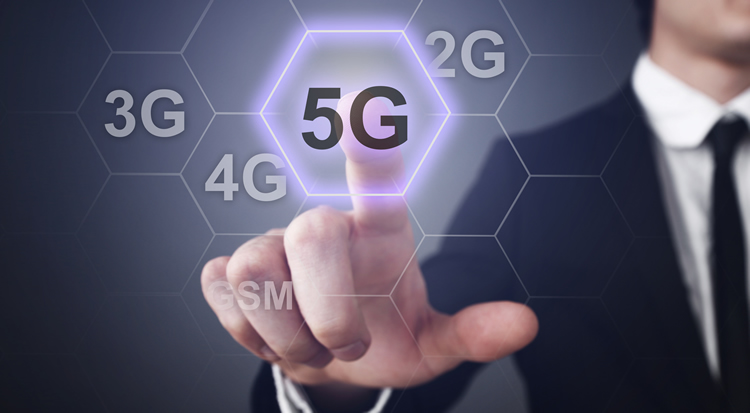
If you’ve read much about 5G then you’ve probably heard about 5G frequencies and spectrum before, but what exactly are these things? How does it work? And what 5G frequencies are in use right now?
Below we’ll answer all those questions and more, so settle in and read on to become a 5G frequency expert.
What are 5G frequencies?
5G frequencies are what mobile networks use to send data between masts and mobile devices, such as smartphones. The same technology is used for 4G and 3G, but the frequencies differ.
Using low frequency bands (such as 700MHz) allows networks to transmit radio waves over very long distances, and they pass through obstacles such as buildings easily. However, the amount of data per second that can be sent over low frequency signals is low.
The opposite is true of using high frequency bands (such as 3.4GHz). Much higher data transfer rates can be achieved (allowing for the sorts of speeds we see with 5G), but the distances over which they can be broadcast are shorter and they struggle to pass through walls and other obstacles. Therefore, mobile networks use a mix of higher and lower bands to provide an ‘always on’ connection with relatively fast data transfer.
But with 5G, there is much greater use of high frequency spectrum than we’ve seen with 4G and 3G. In fact, spectrum in the 3.4GHz band, 3.6GHz band, and even the 26GHz and 40GHz bands has been acquired in 5G spectrum auctions specifically for 5G use. Prior to acquiring spectrum in these bands, most networks topped out at 2600MHz spectrum.
But there’s still a role for lower frequency bands in 5G networks too, as the combination allows a network to deal with all situations.
What is spectrum?
5G spectrum refers to the range of frequencies that enable 5G, but spectrum is a finite resource, so when we talk about the spectrum that networks hold, we’re referring to the amount of capacity they have access to, and the specific parts of the frequency band.
What 5G frequencies are being used in the UK?
At the time of writing the 3.4GHz band, the 3.6-4GHz band, and the 700MHz band are being used for 5G in the UK, while spectrum in the 26GHz and 40GHz bands has also more recently been acquired for 5G use, but isn’t yet integrated into networks at the time of writing. You’ll find more details of these frequencies below.
Note that in most cases we’ve detailed Three and Vodafone separately below, but as these two networks have now merged, they’ll increasingly be sharing spectrum.
The 700MHz band is low frequency spectrum that’s part of the wider sub-1GHz band. Known as the coverage layer, this is designed to provide 5G over wide areas (such as rural locations) and indoors. It relies on low frequency spectrum simply because that travels further than high frequency spectrum, and has less difficulty passing through obstacles, such as walls.
However, as explained above, these low frequency bands are limited in terms of capacity and speed, which means that alone they can’t provide the 5G experience people would expect.
At the time of writing EE, O2 and Three all have some 700MHz spectrum, as detailed below. Vodafone is the odd one out with none – but it has plenty in other bands.
EE
At a spectrum auction regulated by Ofcom in March 2021, EE spent £284 million for 40MHz of spectrum in the 700MHz band. EE has since begun rolling out the 700MHz band across the UK and has switched it on at numerous sites, although few of the sites have been named.
We know however that the first locations to benefit from the deployment were set to be Morecambe, Redditch and Cramlington.
David Salam, EE’s director of mobile networks said that EE has “big ambitions” for 5G connectivity in the next decade and this is the latest milestone in EE’s journey to provide nationwide connectivity.
O2
O2 has also begun its 700MHz band rollout, using kit from Nokia and Ericsson. O2 paid UK regulator Ofcom £280 million to attain a 20MHz slice of the 700MHz spectrum band. We know Cardiff was among the first places to benefit from this spectrum haul, but it’s likely in much wider use now.
Three
Three, meanwhile, spent £280 million on two 10MHz blocks in the 700MHz band and is also likely bolstering its 5G network with this now – though exactly where hasn’t been confirmed.
The 3.4GHz band is much higher frequency. For reference, 4G networks in the UK don’t use any spectrum above 2.6GHz.
Being higher frequency means spectrum is typically available in greater capacity, which allows for higher data speeds of the kind we’re seeing with 5G. However, it doesn’t travel as far or pass through obstacles as well, so combining it with lower frequency spectrum is important for a reliable, widespread 5G network.
Ofcom auctioned off spectrum in the 3.4GHz band in 2018. Three has 20MHz of this spectrum, Vodafone holds 30MHz of this, EE holds 40MHz, and O2 has 60MHz. This spectrum, along with the band detailed below, is the backbone of the UK’s 5G networks, so it’s in wide use.
Note that these holdings have changed since the auction – originally O2 acquired 40MHz of 3.4GHz spectrum and Vodafone acquired 50MHz, but the latter sold some to O2 as part of a deal tied to Vodafone’s merger with Three.
The 3.6GHz-4GHz band is higher frequency still, so its positive and negative points are further emphasised. However, along with the 3.4GHz spectrum (and all other spectrum between 1GHz and 6GHz) it’s part of the sub-6GHz 5G band, which is designed as a combined coverage and capacity layer.
In other words, all this spectrum is essentially the backbone of a 5G network, as it strikes a good balance between easily allowing for widespread coverage and supporting high speeds.
EE, Vodafone, and O2 all hold 40MHz of spectrum in the 3.6GHz-3.8GHz range, while Three holds 120MHz of spectrum in the wider 3.6GHz-4GHz range.
Spectrum in the 26GHz and 40GHz bands was auctioned off more recently than the bands above, at a spectrum auction held in 2025.
We’re clumping these two bands together because they’re both vastly higher frequency than the previous bands, and because the situation of how much spectrum in each band is held by each network is more straightforward.
These high frequency bands (ones of above 6GHz) are known as mmWave, and can deliver super-fast data rates beyond what we’ve seen so far from the UK’s 5G networks. Of course, being so high frequency their ability to cover wide areas or interiors is also a lot more limited.
As such, these bands are ideal for boosting capacity in high-density areas like stadiums and airports, and indeed it’s specifically planned that this spectrum will be used in 68 such areas across the UK.
As for how much of this spectrum each network has – EE, VodafoneThree (collectively), and O2 each have 800MHz of spectrum in the 26GHz band and 1GHz of spectrum in the 40GHz band.
That said, with the auction only completing in October of 2025, this spectrum isn’t yet being used by the networks at the time of writing – but if you’re reading this in 2026 or beyond it might well be.
What 5G frequencies may be used in future?
At the time of writing (December 2025), the UK’s third 5G spectrum auction (covering spectrum in the 26GHz and 40GHz bands) has recently concluded, and the main networks have all secured spectrum from it.
Looking ahead, Ofcom is known to be freeing up spectrum in the 8GHz band, as well as the 1492-1517MHz band.
Ofcom is also looking into potentially opening up the 32GHz, 37-43.5GHz and 66-71GHz bands to mobile networks at some point in the future.
Beyond auctions, it’s possible that some of the spectrum currently or previously being used for 4G, 3G and 2G networks could be repurposed to support 5G. Indeed, most networks have shut down their 3G services now, so additional spectrum could soon be used for 5G. This spectrum is quite low frequency, ranging from 800MHz to 2600MHz.
How much 5G spectrum do the UK’s networks have?
|
Network
|
5G spectrum holdings
|
|
EE
|
1,920MHz
|
|
O2
|
1,920MHz
|
|
VodafoneThree
|
2,030MHz
|
Following the third 5G spectrum auction (held in October 2025), the 5G spectrum holdings of each network are as shown in the chart above.
Although we separated Vodafone and Three in most cases above, we’ve combined them into one entity (VodafoneThree) here, as at the latest spectrum auction they bid as one entity.
As you can see, VodafoneThree has the most spectrum, which is largely down to Vodafone and Three merging and therefore sharing their spectrum, but it’s also thanks to Three’s prior purchase of UK Broadband. This merged company’s collective 5G spectrum includes 1GHz of 40GHz spectrum, 800Mhz of 26GHz spectrum, 50MHz of 3.4GHz spectrum, 160MHz in the 3.6-4GHz range, and 20MHz of 700MHz spectrum. You can see how that breaks down between Vodafone and Three individually in the sections above.
EE, meanwhile, has 1GHz of 40GHz spectrum, 800Mhz of 26GHz spectrum, 40MHz in the 3.4GHz band, 40MHz in the 3.6GHz band, and 40MHz in the 700MHz band.
Then O2 has 1GHz of 40GHz spectrum, 800Mhz of 26GHz spectrum, 60MHz in the 3.4GHz band, and 40MHz in the 3.6GHz band, as well as 20MHz in the 700MHz band.
It’s not just the amount of spectrum that matters though, but also how it’s positioned, with large blocks of contiguous spectrum being more desirable. To that end, we’ve seen some networks trade spectrum to build up a contiguous block.
For example, we’ve seen O2 and Vodafone arrange to trade some of their spectrum so that O2 can obtain an 80MHz contiguous block, while Vodafone can bring its spectrum closer together.
It’s worth noting that Three has an even bigger 100MHz contiguous block, but this was arranged with Ofcom, rather than being the result of trading with another network.










